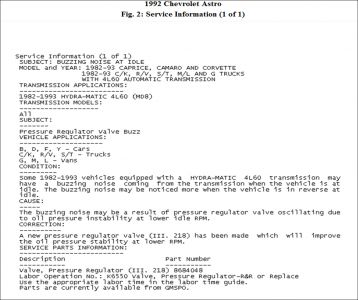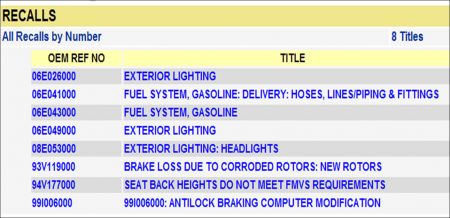Hello -
One other thing. . ...since I can't hear the noise. . ..there are a couple of transmission TSB that discuss a noise. . ...please review and see if this is what you may be hearing.
Information on Driveline Clunk Noise When Shifting Between PARK and DRIVE, PARK and REVERSE or DRIVE and REVERSE
TECHNICAL SERVICE BULLETIN
Reference Number(s): 99-04-20-002E, Date of Issue: June 06, 2008
Affected Model(s): 2009 and Prior GM Passenger Cars and Light Duty Trucks (including Saturn); 2009 and Prior HUMMER H2, H3; 2009 and Prior Saab 9-7X
Supercedes: This bulletin is being revised to add model years. Please discard Corporate Bulletin Number 99-04-20-002D (Section 04 - Driveline/Axle).
Related Ref Number(s): 56-44-01, 56-44-01A, 99-04-20-002, 99-04-20-002A, 99-04-20-002B, 99-04-20-002C, 99-04-20-002D, 99-04-20-002E
ARTICLE BEGINNING
SERVICE INFORMATION
IMPORTANT: The condition described in this bulletin should not be confused with the following previous bulletins:
"Â Info - Discontinue Flushing and Replacing Transfer Case Fluid Due to Bump/Clunk Concern (Corporate Bulletin Number 99-04-21-004A or newer).
"Â Clunk, Bump or Squawk when Vehicle Comes to Complete Stop or Accelerating from Complete Stop (Replace Rear Drive Shaft Nickel-Plated Slip Yoke) (Corporate Bulletin Number 01-04-17-004B or newer).
Some owners of vehicles equipped with automatic transmissions may comment that the vehicle exhibits a clunk noise when shifting between Park and Drive, Park and Reverse, or Drive and Reverse. Similarly, owners of vehicles equipped with automatic or manual transmissions may comment that the vehicle exhibits a clunk noise while driving when the accelerator is quickly depressed and then released.
Whenever there are two or more gears interacting with one another, there must be a certain amount of clearance between those gears in order for the gears to operate properly. This clearance or freeplay (also known as lash) can translate into a clunk noise whenever the gear is loaded and unloaded quickly, or whenever the direction of rotation is reversed. The more gears you have in a system, the more freeplay the total system will have.
The clunk noise that owners sometimes hear may be the result of a buildup of freeplay (lash) between the components in the driveline.
For example, the potential for a driveline clunk would be greater in a 4-wheel drive or all-wheel drive vehicle than a 2-wheel drive vehicle. This is because in addition to the freeplay from the rear axle gears, the universal joints, and the transmission (common to both vehicles), the 4-wheel drive transfer case gears (and their associated clearances) add additional freeplay to the driveline.
In service, dealers are discouraged from attempting to repair driveline clunk conditions for the following reasons:
"Â Comments of driveline clunk are almost never the result of one individual component with excessive lash, but rather the result of the added affect of freeplay (or lash) present in all of the driveline components.
Because all of the components in the driveline have a certain amount of lash by design, changing driveline components may not result in a satisfactory lash reduction.
"Â While some owners may find the clunk noise objectionable, this will not adversely affect durability or performance.
"Â For additional diagnostic information, refer to the appropriate Service Information.
The next one

Monday, October 5th, 2009 AT 6:52 PM


